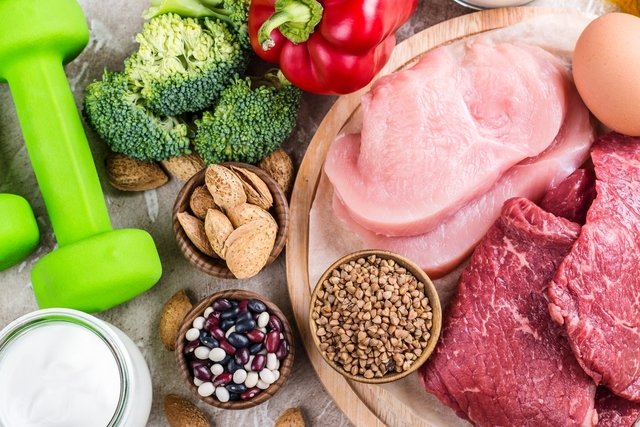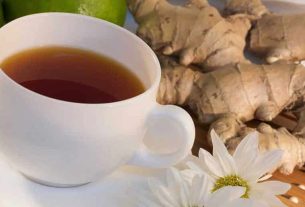The diet for hypertrophy and fat loss must be rich in proteins, good fats and whole grains, in addition to being low in simple sugar and saturated fats. Furthermore, it is important that it is accompanied by regular physical activity, adequate intake of fluids and adequate rest.
Furthermore, it is also important to practice physical activities daily, such as weight training and CrossFit, which will stimulate muscle mass gain. On the other hand, doing about 30 minutes of aerobic exercise, such as walking and cycling, helps stimulate fat loss without decreasing muscle mass.
To lose body fat, it is important to burn more calories than you consume. However, low calorie consumption throughout the day can cause loss of muscle mass and worsen physical performance. Therefore, it is advisable to consult a nutritionist to develop a diet suited to individual needs.

What should the diet be like?
Diet recommendations for gaining muscle mass and losing fat are:
1. Eat protein-rich foods
Eating protein-rich foods at every meal, such as lean red meat, fish, chicken, turkey, eggs, tofu, cheese and low-fat yogurt, is important for maintaining muscle mass and hypertrophy.
The amount of protein that should be consumed to increase muscle mass varies according to the intensity of physical activity practiced, weight, sex and age of each person, and between 0.8 and 2g/kg of body weight may be recommended. of protein per day. Check the amount of protein recommended for each person.
2. Prioritize whole grains
Prioritizing whole grains, such as quinoa, oats, whole grain bread, rice, pasta and whole grain biscuits is important for fat loss, as they are rich in fiber that helps control satiety, reducing food intake throughout the day.
In addition, whole grains also help with hypertrophy because they have good amounts of carbohydrates, a nutrient that helps restore energy to the muscle immediately after physical exercise. Understand better what carbohydrates are for.
3. Eat fruits and vegetables daily
Eating fruits and vegetables daily, such as oranges, apples, papayas, bananas, spinach, carrots, eggplants and zucchini, helps with fat loss, because they are rich in fiber that prolongs satiety throughout the day.
In addition, fruits and vegetables are also good sources of carbohydrates, vitamins and minerals that are important for muscle formation and hypertrophy.
4. Consume healthy fats
Healthy, or good, fats such as peanuts, cashews, almonds, olive oil, sardines, avocado and coconut help with hypertrophy, because fat is essential for the production of hormones that act in the formation of muscle cells. Check out other foods rich in good fats.
Healthy fats also provide energy for the body, improving performance during training and thus helping with hypertrophy and loss of body fat.
5. Drink plenty of water
Drinking plenty of water throughout the day, around 2 liters per day, helps with fat loss, because it balances your appetite, reducing food intake and calorie consumption. Know how many liters of water to drink per day.
Furthermore, drinking plenty of water also promotes hypertrophy, because this drink acts on muscle contraction, in addition to being essential for the storage and release of muscle glycogen, helping to provide energy during physical exercise.
Foods that should be avoided
To ensure hypertrophy and fat loss, it is important to avoid the following foods:
- Foods rich in sugar, such as ice cream, cake, soft drinks, cookies and cakes;
- Meats rich in fatsuch as sausage, picanha, rib, skirt steak and termite;
- Built-ins, such as sausage, sausage, ham, mortadella and salami;
- Refined cereals, such as white bread, white pasta and white rice;
- Industrialized seasonings, such as mayonnaise, ketchup, ready-made sauces and ready-made seasonings in powder or cubes.
Furthermore, it is also recommended to avoid the consumption of alcoholic beverages, such as beer, wine and sparkling wine, as these drinks can reduce metabolism, the formation of muscle cells, in addition to reducing the body’s ability to burn fat.
Menu to gain hypertrophy and lose fat
The following table shows an example of a 3-day menu for hypertrophy and fat loss:
The quantities and types of food on the menu may vary according to age, weight, height and physical activity. Therefore, it is important to consult a nutritionist so that a complete assessment can be carried out and a nutritional plan created according to individual needs.
If you want an individualized diet, make an appointment with the nutritionist closest to you:
Taking care of your health has never been easier!
Are nutritional supplements necessary?
Normally, the appropriate eating plan and physical activity are enough to lose fat and gain muscle mass. However, in some cases, it is possible to resort to the use of dietary supplements to help increase muscle mass and performance in physical activity, and it is important that this is guided by a doctor or nutritionist.
Among the most used supplements are whey protein, which is made from cow’s milk, helping to increase strength and physical performance. There are also amino acid supplements that prevent muscle breakdown during intense exercise.
Other tips for hypertrophy and fat loss
Other tips that help with hypertrophy and fat loss are:
- Regularly practice strength exercises, such as weight training, calisthenics or Crossfit, and aerobic activities, such as dancing, running and skating;
- Sleep 7 to 9 hours per nightas sleep balances the production of ghrelin and leptin, which are hormones that regulate hunger and satiety, facilitating fat loss;
- Chew food well and slowly, as it increases the duration of meals, helping the brain to understand that the stomach is full and that one should stop eating, thus promoting fat loss.
Furthermore, the use of some nutritional supplements, such as whey protein, creatine and BCAA, also promotes muscle mass gain. Discover supplements to gain muscle mass.

Sign up for our newsletter and stay up to date with exclusive news
that can transform your routine!
Warning: Undefined array key "title" in /home/storelat/public_html/wp-content/plugins/link-whisper-premium/templates/frontend/related-posts.php on line 12
Warning: Undefined array key "title_tag" in /home/storelat/public_html/wp-content/plugins/link-whisper-premium/templates/frontend/related-posts.php on line 13



